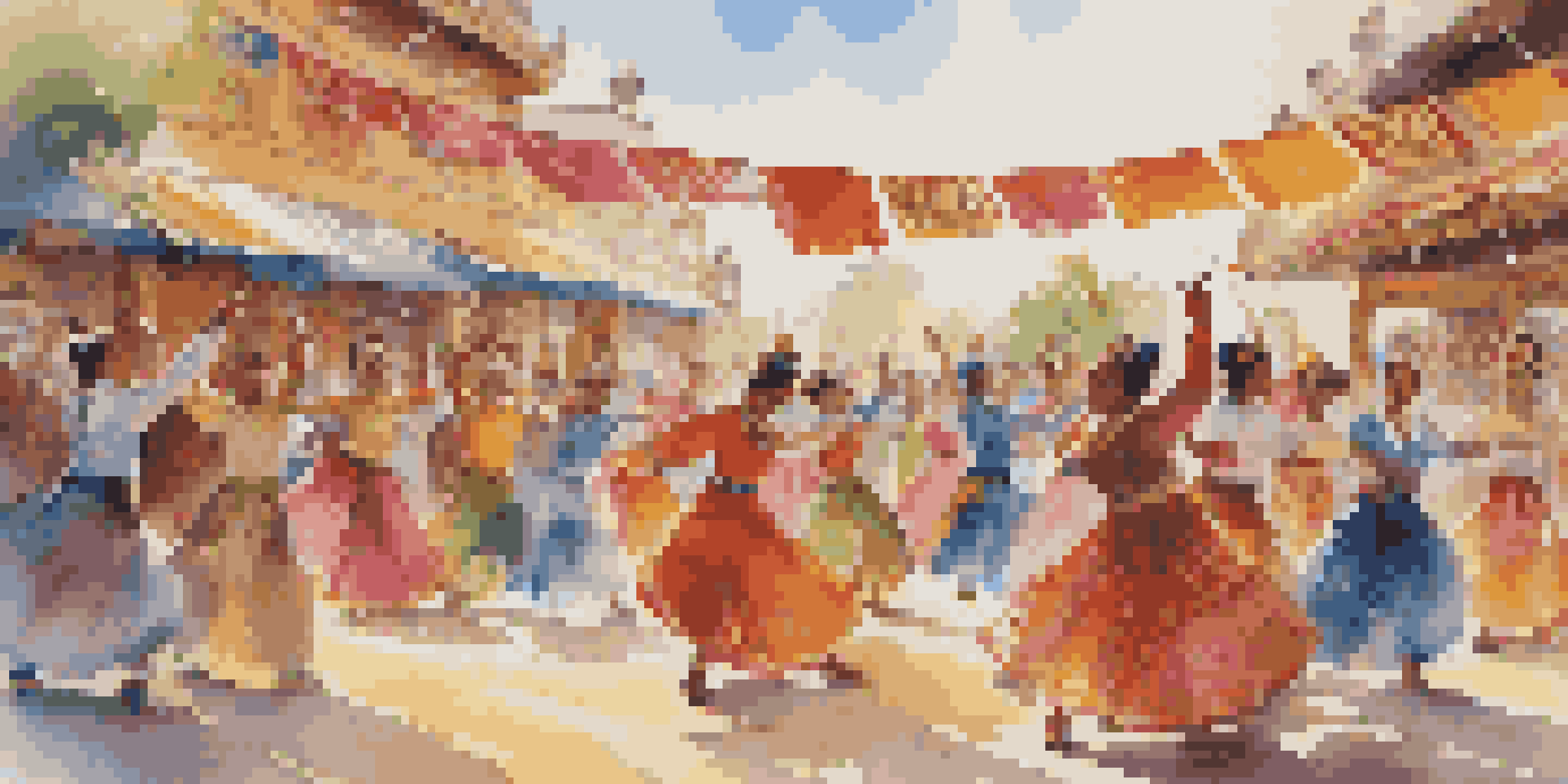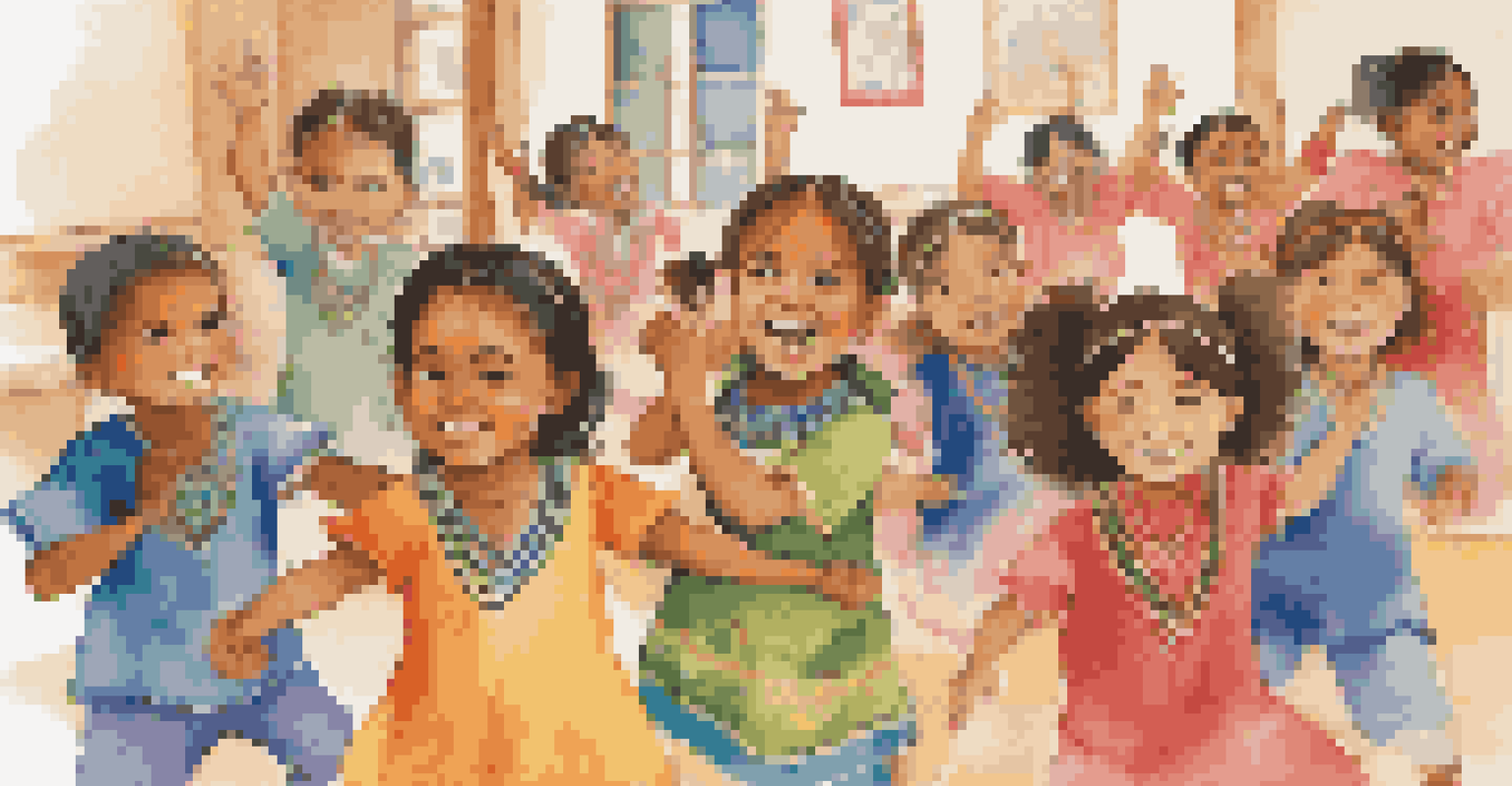Cultural Exchange: Dance and Folklore in Global Contexts

Understanding Cultural Exchange Through Dance
Cultural exchange is a fascinating concept that encompasses the sharing of traditions, beliefs, and practices between different societies. Dance, as a universal language, plays a crucial role in this exchange. It allows individuals to express emotions, tell stories, and connect with others, transcending barriers like language and geography.
Dance is the hidden language of the soul.
When we think about dance, we can visualize diverse forms from the tango in Argentina to the traditional hula in Hawaii. Each dance style reflects the unique history and culture of its origin, offering a glimpse into the values and experiences of its people. This rich tapestry of movement showcases how cultures influence and inspire one another.
As people travel and interact, they bring their dance traditions along, creating a beautiful fusion of styles. For instance, the global popularity of hip-hop has led to its adaptation in various countries, merging local influences with original elements. This ongoing dialogue enriches both the art of dance and the cultures involved.
Folklore: The Heartbeat of Cultural Identity
Folklore encompasses the myths, legends, and stories passed down through generations, serving as a cultural cornerstone for communities worldwide. Just like dance, folklore helps to preserve the identity and values of a culture, offering insights into its history and beliefs. Through tales of heroes, gods, and everyday life, folklore connects the past with the present.

For example, Native American folklore often includes stories that reflect a deep respect for nature and the interconnectedness of all living things. Similarly, African folklore is rich with lessons about morality and community, often featuring animals as characters that teach valuable life lessons. These stories foster a sense of belonging and continuity among the people.
Dance Fosters Cultural Exchange
Dance acts as a universal language, enabling the sharing and blending of cultural traditions across the globe.
The exchange of folklore between cultures can also lead to new interpretations and adaptations of traditional tales. As stories are shared and retold in different contexts, they evolve while maintaining their core messages. This fluidity highlights the dynamic nature of cultural identity and the importance of storytelling in fostering understanding.
The Role of Dance Festivals in Cultural Exchange
Dance festivals serve as vibrant platforms for cultural exchange, bringing together performers from various backgrounds to celebrate their traditions. These events not only showcase unique dance styles but also encourage dialogue between artists and audiences. Attendees have the opportunity to experience different cultures firsthand, fostering appreciation and understanding.
Folklore is the heart of a community, connecting generations through shared stories and traditions.
For instance, festivals like the Edinburgh Festival Fringe or the International Dance Festival in Lyon attract dancers from all over the world, creating a melting pot of styles and influences. Participants often collaborate, blending techniques and storytelling methods, which leads to innovative performances that reflect a shared human experience. These interactions enrich both the artists and the spectators, creating lasting memories.
Moreover, dance festivals often include workshops and discussions, allowing participants to gain deeper insights into the cultural significance behind each performance. This educational aspect encourages participants to engage with the art form on a more personal level, breaking down stereotypes and building connections across cultures.
Dance as a Means of Social Change
Throughout history, dance has played a significant role in social movements, serving as a powerful tool for expression and activism. From the civil rights movement in the United States to contemporary movements advocating for gender equality, dance has been used to raise awareness and inspire change. It allows individuals to voice their experiences and challenges through the art of movement.
For example, the Dance for Peace initiative in various countries uses choreography to promote messages of unity and reconciliation in conflict zones. By bringing people together through dance, these initiatives foster community and understanding, demonstrating how art can transcend divisions. Through shared experiences, participants often find common ground, leading to healing and social progress.
Folklore Preserves Cultural Identity
Folklore serves as a cornerstone for communities, preserving their unique stories and values through generations.
Moreover, social media platforms have amplified the impact of dance as an agent for change. Viral challenges, such as the 'Dance Challenge for Justice,' have mobilized individuals worldwide to express solidarity and raise awareness for important causes. This digital landscape allows dancers to connect with a global audience, amplifying their message and showcasing the power of movement in the fight for justice.
Exploring Traditional Dances from Around the World
Traditional dances often embody the unique cultural heritage of a community, showcasing its values, history, and social norms. For instance, the Bharatanatyam dance from India tells stories of Hindu mythology through intricate movements and expressions, preserving its ancient rituals while adapting to contemporary stages. Each dance is like a window into the soul of its culture.
In contrast, the Irish jig, with its lively footwork and energetic music, reflects the joy and resilience of the Irish people. Such dances not only entertain but also serve as a reminder of cultural pride and continuity, often performed during significant events and celebrations. They bring communities together, reinforcing their shared identity and traditions.
As globalization continues to influence cultural practices, these traditional dances are often blended with modern styles, creating hybrid forms that resonate with new audiences. This fusion allows traditional dances to remain relevant while honoring their roots, thus ensuring that the stories and meanings they carry are not lost over time.
The Impact of Technology on Dance and Folklore
Technology has revolutionized the way we experience and share dance and folklore, making them more accessible than ever before. Online platforms and social media enable dancers to showcase their skills, share traditional practices, and connect with a global audience. This digital landscape has transformed how cultural stories are told and celebrated.
For instance, platforms like YouTube and TikTok have allowed traditional dance forms to gain popularity outside their cultural contexts, inspiring new generations to learn and engage with these art forms. Dance challenges and tutorials have become viral sensations, bridging gaps between cultures and creating a sense of community among participants worldwide. This democratization of dance fosters appreciation for diverse cultural expressions.
Technology Enhances Dance Accessibility
The rise of technology and social media has transformed how dance and folklore are shared, making them more accessible while raising questions about authenticity.
However, while technology offers new opportunities for cultural exchange, it also raises questions about authenticity and representation. As traditional dances are adapted for online consumption, it’s important to preserve their cultural significance and avoid oversimplification. Balancing innovation with respect for tradition can help ensure that the rich narratives behind these art forms continue to thrive.
Preserving Cultural Heritage Through Dance and Folklore
As globalization reshapes our world, the preservation of cultural heritage becomes increasingly vital. Dance and folklore serve as vessels for this heritage, carrying the stories, values, and traditions of communities through generations. Efforts to document and teach these art forms are crucial in maintaining the unique identities of cultures worldwide.
Organizations and grassroots movements are actively working to preserve traditional dances and folklore through workshops, performances, and educational programs. By engaging younger generations and encouraging them to participate, these initiatives ensure that cultural practices are passed down and adapt to contemporary contexts. This preservation is not only about keeping traditions alive but also about fostering pride and identity.

Additionally, collaborations between communities and cultural institutions can amplify these preservation efforts. By sharing resources and knowledge, they can create dynamic programs that celebrate diversity while emphasizing the importance of heritage. In this way, dance and folklore become not just art forms but essential components of cultural continuity and resilience.